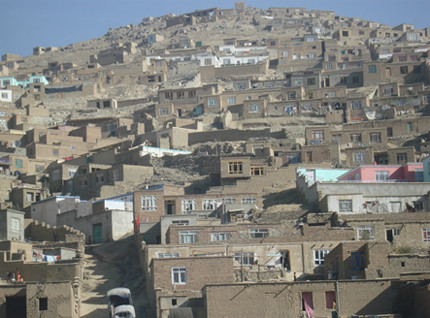Most people in the Afghan capital Kabul live in illegal, unplanned and sub-standard houses that are prone to natural disasters and lack water and sanitation facilities, according to government officials.

About three million people are living in illegal and unplanned houses in the Afghan capital Kabul (Photo: IRIN)
"Of the [estimated] five million people currently living in Kabul, at least three million are residing in illegal and unplanned houses," Abdul Wahab Sadaat, deputy director of city services at the Kabul Municipality, told IRIN.
"These houses - which make up about 75 percent of the houses in Kabul - are also vulnerable to earthquake, floods and other natural disasters," said Sadaat.
Over the past seven years some militia commanders and powerful groups have seized and sold public property and land, creating a crisis of unregulated urbanization in the capital, officials in the municipality and in the Ministry of Urban Development said.
The rapid and mostly unplanned urbanization in Kabul has brought about serious environmental, health and social problems.
The population of Kabul has grown substantially, from about one million in 2001 to about five million in 2009, exhausting the city's already limited natural resources, particularly underground water reserves, say government and independent specialists.
"Should the use of underground water continue at its current pace, by 2020 the capital will suffer a serious water shortage," said Noor Ahmad Jawad, a meteorologist at Kabul University.
Meanwhile, many of the mushrooming squatter communities lack water, proper sanitation and health facilities, while waste management in Kabul is becoming a major concern.
Rapid population growth and urbanization, coupled with limited resources, have put a heavy burden on Kabul's environment and air quality which, according to health officials, hastens the death of more than 3,000 people annually.
"Greater Kabul"
Officials privately concede they are unable to resolve the crisis of illegal houses in Kabul because of the magnitude of the problem involving millions of people and the involvement of influential individuals who have profited from unregulated urbanization.
Instead, the government and several private companies have drawn up plans for a "Greater Kabul", which is expected to be built on 740 sqkm to the northeast of the city in the next 15-20 years.
"The new, greater Kabul plan addresses all the shortages and problems which we currently have in Kabul city," said Sadaat.
The new city, which will accommodate 1.5 million people initially and three million in the long run, will require US$35.5 billion over 16 years, of which $24 billion should come from the private sector and $11.5 billion from the government and donors, according to officials.
The population in Kabul is predicted to surpass eight million by 2025.
The new city looks good on the map, but specialists question whether the people who have built illegal and sub-standard houses in Kabul will be willing or able to pay for new houses in the greater Kabul.



